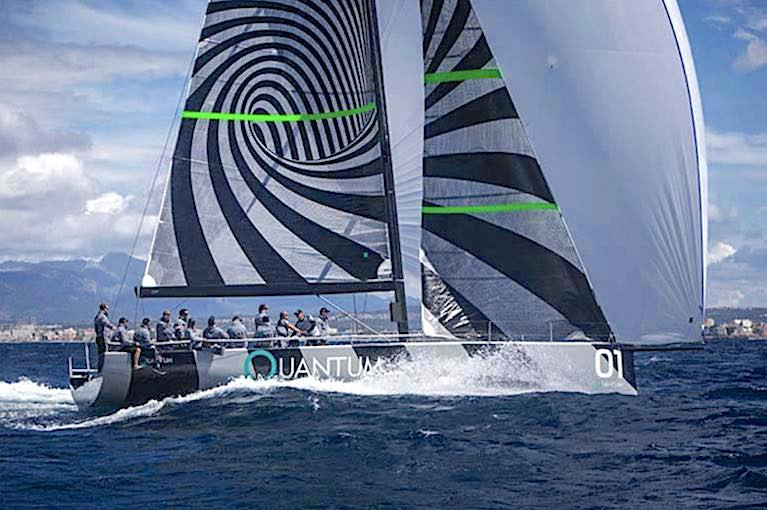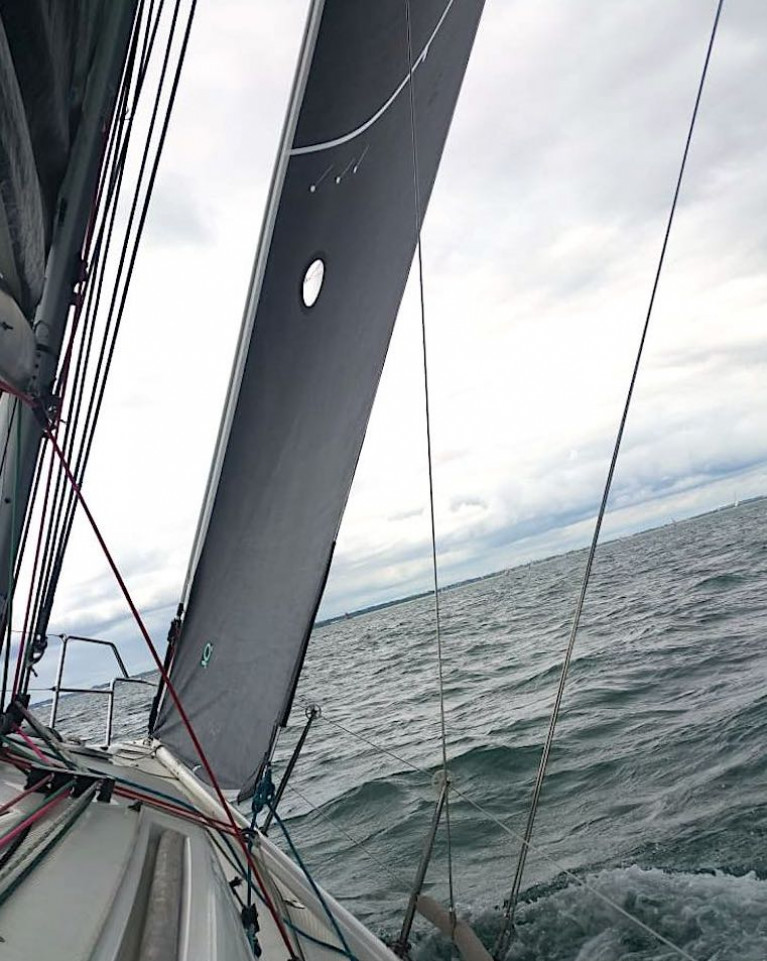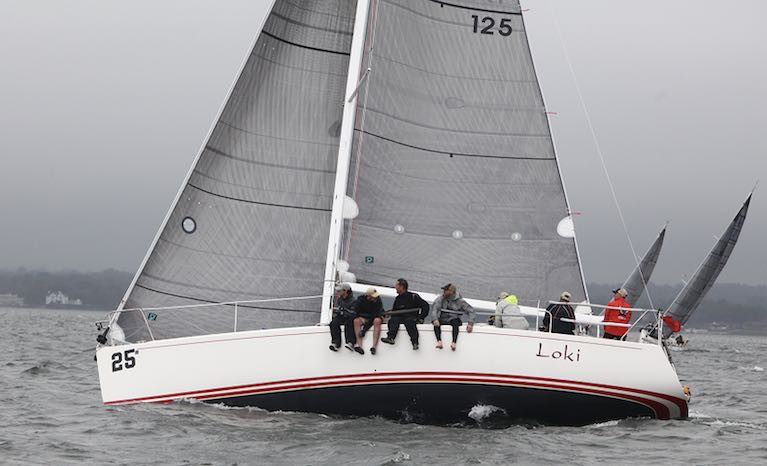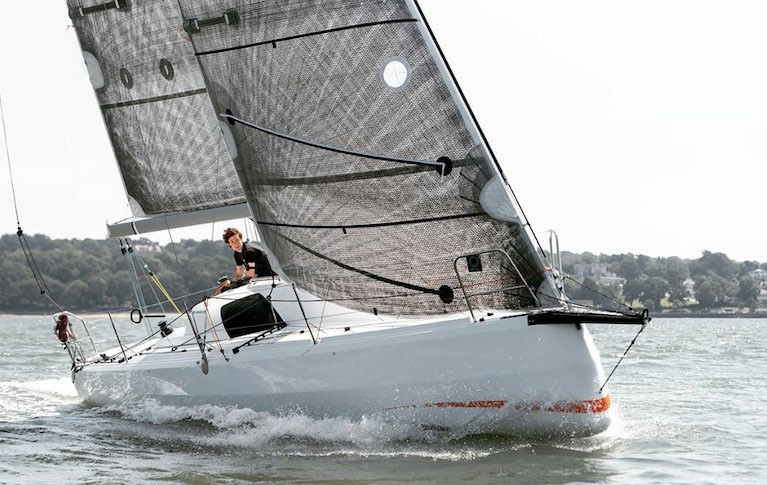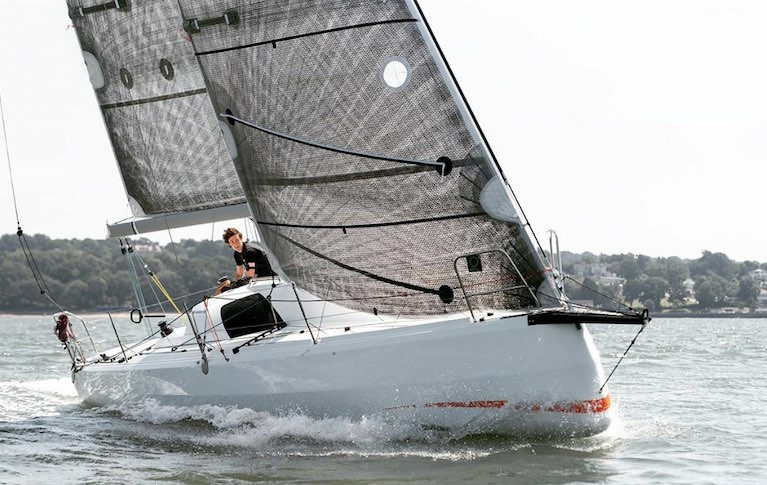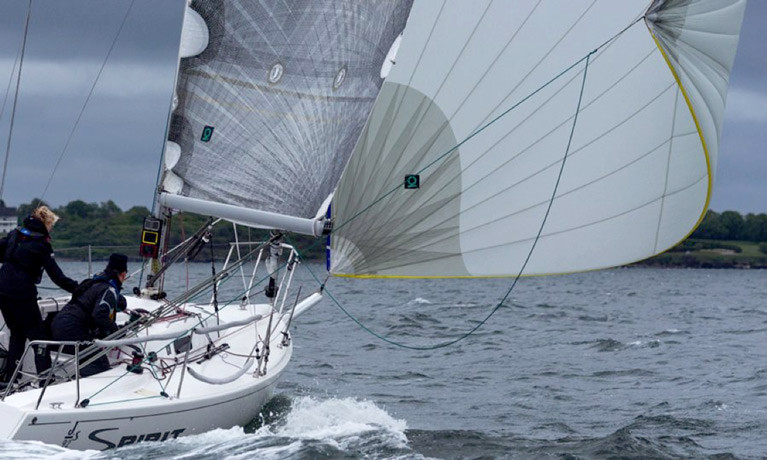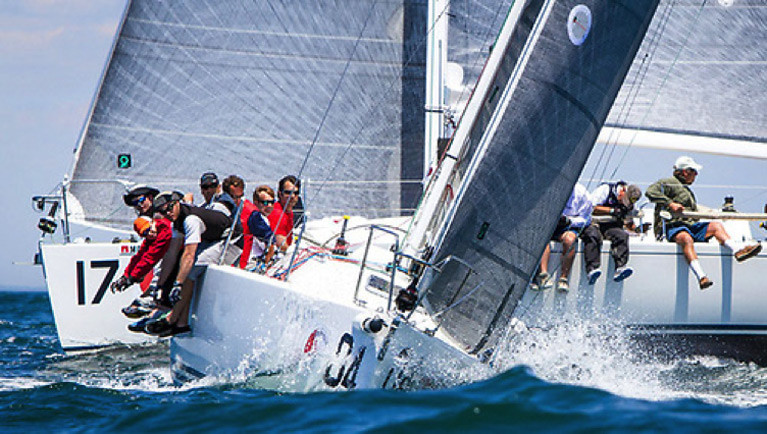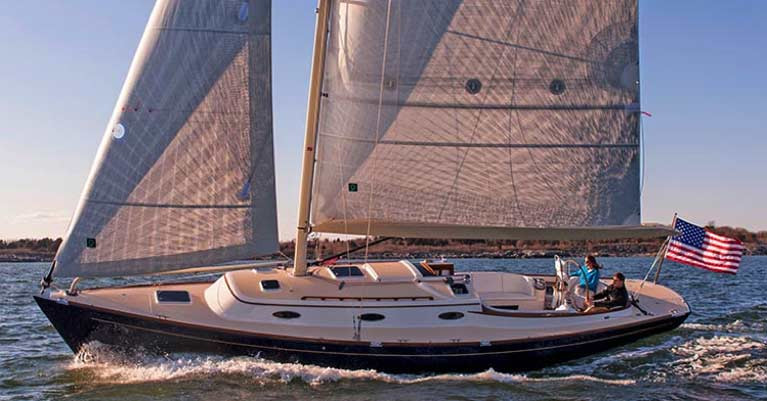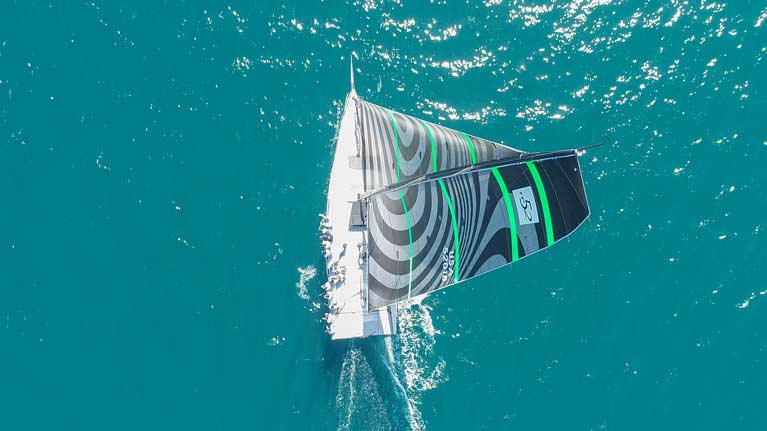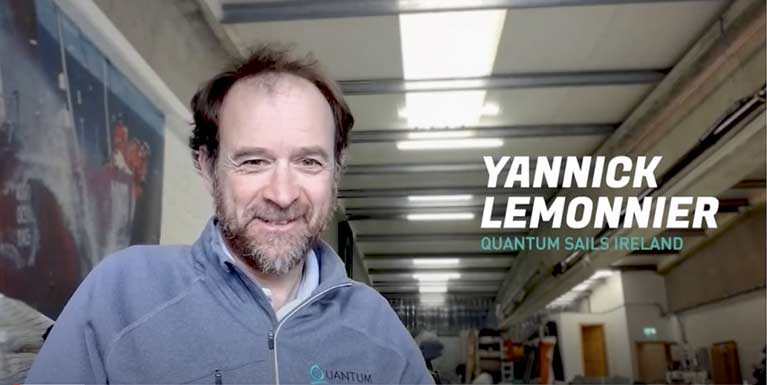Displaying items by tag: Quantum Sails
Spinnakers - What is the Best Sail Cloth Material?
Whether you are racing or cruising, the choice of the cloth that your spinnaker is made from is important for speed and longevity. Mark Mansfield from Quantum Sails goes through the main options and suppliers of spinnaker cloth. Quantum Sails can provide spinnakers in all manufacturers' materials, depending on an owner's choice.
Racing options
The vast majority of nylon downwind sails are made by 2 Suppliers. Contender from Holland produces the Superkote/Superlite range of PU impregnated nylons.
Bainbridge from the UK produces the PU Impregnated AirX range. Both are similar, but there are specific differences.
Contender Superkote/Superlight - Contenders Superkote/Superlite would be the most popular of racing nylons for all-round use. Available in 12 different weight ranges and 14 different colours, it covers a vast range of options. Superlite is generally for smaller boats of less than 30 feet. Superkote is the main Spinnaker range for boats over 30 foot.
Bainbridge AirX - Bainbridge is a Uk company and has been in the sailmaking and sailcloth production business since 1917 when they originally produced sails for large commercial sailing Ships. Now a top-level cloth manufacturer, their products have won Americas Cups, Round the World races and Olympics. Their AirX range has seven different weights and 12 different colours.
 Quantum A2 spinnaker running Superkote SK75 Photo: Quantum Sails
Quantum A2 spinnaker running Superkote SK75 Photo: Quantum Sails
So what's the difference?
Both AirX and Superkote are produced as light as possible and feature a highly resonated finish that adds both strength and water resistance to its exterior and interior ripstop material. The AirX range has more 'resination' than Superkote and so feels crispier than Superkote, even when used quite a bit. Superkote is less stiff, particularly diagonally.
For running spinnakers, Superkote is believed to be more flexible and less stiff in light and moderate conditions and so is likely the better all-round option. Less stiff means it bounces around less and possibly needs less trimming. However, In stronger air and particularly reaching when the sail is powered up, the lack of Diagonal movement in the Airx is an advantage.
Cost-wise AirX cloth is less expensive than Superkote, and the difference in a sail can be 10% to 15%.
 Gringo, the Dublin Bay A35 running downwind
Gringo, the Dublin Bay A35 running downwind
What cloth weight?
Most owners will be aware of the term .75 oz. and half oz. And might think that their sails weigh that figure. So for instance Contender, Superkote 75 would be the most popular weight in their range and is very popular for midrange yachts of around 35 foot. Superkote 75 weighs .93 of an Oz.
Weight range performance Superlite and Superkote
 Weight range performance Superlite and Superkote Table via Quantum Sails
Weight range performance Superlite and Superkote Table via Quantum Sails
Weight options
If an owner of a mid-range racing boat was changing just one spinnaker, it more than likely would be their all-round runner. In a Symmetric, this would be their S2. In an Asymmetric boat, like a J109, this would be their A2. As a result, they likely would go for a cloth weight that would do them from 5 knots right up to 20/25 knots. If it were Contender Superkote, then that likely would be the SK75. If it were AirX, then that likely would be AirX 600.
However, this wind range (5 to 25 knots) is quite large so for performance in lighter air, it would be better to have a lighter cloth, so Superkote SK60 would be a very nice option from 5 to 18 knots or so, then Superkote 90 above that. Effectively the Sk90 would be an A4 (heavy running Asymmetric spinnaker). We have just sold a pair of Spinnakers to a top J109 in Dublin, who would have previously just gone for a standard all-round runner SK 75, and now will have a heavy and a light runner. Also using an All-round Spinnaker in 20 to 25 knots runs the risk of tearing, particularly when broaching or even launching the spinnaker.
A heavy Runner, or a Reacher in a heavy cloth, will likely last a very long time due to the cloth weight and the fact that they would not be used that often each season. On the other hand, the Light runner wears out quickly as it is used 80% of the time and often is carried over its range. Once a resonated cloth like SK75 or Airx 600 starts to get soft or retains water easily, it likely is not as quick or efficient. Also, as it is not as slippery, it takes longer to launch, and notably in an Asymmetric, takes a lot longer to set coming out of a gybe as the cloth clings to itself during the gybe. The cloth, once it loses its finish, becomes a bit porous and a small amount of performance is lost due to the wind passing through the cloth. Competitive racing boats will change their all-round light air spinnaker every year or two and the benefits of a new sail become very clear. A main or a Headsail will show its age and speed loss; however, a spinnaker will still look OK when it becomes slow.
Cruising spinnakers
For Cruising sailors the time that a spinnaker is changed if often when the previous one explodes and is not worth the big expense of a repair. Often the cloth has broken down, or the stitching on the corners has started to deteriorate.
Cruising Spinnaker cloth is normally less resonated and so will not be as crispy. The material itself will likely be heavier and the threads, as a result, are denser. The extra weight is not normally as important, and extra threads make it less resistant to tearing. When not set it often will sink down to the end of the sail bag as without the extra coating, it takes up less room in the bag.
Bainbridge and Contender again lead the pack with their Products, Bainbridge has their MP range and Contender have their Nylite range. Both options would be less expensive than their Racing Counterparts (Superkote and AirX). Of the two MP from Bainbridge would again be less expensive than Nylite.
Other options for cruising spinnakers
Cruising sailors who only want one spinnaker aboard recently look at the cruising range of Asymmetric sails that can be set on a top-down furler. This can be either a Code 0 or an Asymmetric Cruising spinnaker. The ease of launching and retrieving is the main advantage over a conventional spinnaker. Code 0's are now coming in cable-less forms allowing the halyard to be eased when the wind in further aft to give the sail more power and then when the wind is more forward, the halyard is kept firm to give a flatter entry. Quantum sails have a range of Cabled and Cable less A sails and Code 0's for cruising sailors. I will do another article shortly specifically on Code 0's.
Quantum would be delighted to quote for any new racing or cruising Spinnakers (or upwind sails) which can be specified in any suitable Material. Contact Mark Mansfield at [email protected] or by phone at 00 353 87 250 6838
Quantum Sails Winter Discounting (Up to 15%) is Ending Mid October
Quantum Sails Ireland is reminding interested parties that its winter discounting of up to 15% is ending in two weeks.
Since Quantum Sails brought out the offer, they have seen a big increase in sail orders all over the country and in particular in the South of Ireland, in Dublin and in Northern Ireland.
Recent Quantum articles on Afloat, such as this one here have highlighted how competitive its sails are, on the water, and in terms of pricing.
Last weekend, top half tonner, Miss Whiplash from Cork, took possession of their new Quantum Fusion M5 Mainsail and went on to win the first race in IRC SPIN 1 Division of the RCYC AIB Autumn League.
 Miss Whiplash, Half Tonner, new mainsail – Quantum Fusion M5
Miss Whiplash, Half Tonner, new mainsail – Quantum Fusion M5
Some photos of Quantum Fusion sails are also featured below.
For any enquiries or quotes, contact Mark Mansfield at [email protected] or by phone at 00353 87 250 6838
 Sunfast 3300 with Quantum Fusion M5 main, staysail and Code 0
Sunfast 3300 with Quantum Fusion M5 main, staysail and Code 0
 Quantum cruising laminate radial main and jib
Quantum cruising laminate radial main and jib
 Quantum Fusion M5 in clear version (without dark skin) on a Sunfast 3300
Quantum Fusion M5 in clear version (without dark skin) on a Sunfast 3300
Quantum Sails J109: Winner of USA Nationals Every Year from 2014 - Six Years Running
Irish Quantum Sails agent Mark Mansfield, a J109 specialist himself, highlights the amazing run of victories for Quantum Sails in the J109 class in the United States. Three different Quantum Sails boats have won the J109 US Nationals since 2014 right up to 2019. There was no US J109 Nationals in the US in 2020 due to Covid. From 2016 to 2019, the same J109, Loki, has won the Nationals each year, while in 2014 and 2015, two different Quantum sails boats were victorious.
 Quantum Fusion 5 J109 Mainsail
Quantum Fusion 5 J109 Mainsail
In the United States, Quantum, along with another sailmaker, share the majority of the racing market. In Ireland and the UK, many owners do not appreciate how competitive Quantum has been in recent years.
 A Quantum Fusion J109 headsail on a winning US J109
A Quantum Fusion J109 headsail on a winning US J109
Many will know that the US America's Cup foiling monohull—American Magic, uses Quantum sails and two of the Top TP 52s on the TP Circuit, Platoon and Quantum Racing, both use full Quantum inventories. However in Ireland, few will appreciate how well the brand does in one design and other events like the J109 class.
 American Magic, the foiling America's Cup challenger uses Quantum Fusion sails
American Magic, the foiling America's Cup challenger uses Quantum Fusion sails
The J109 class over there also uses non-overlapping headsails, as they do in Ireland. The option of choice for these winning J109's has been the Quantum Fusion 5 and Fusion 7 Carbon Membrane sails, with Superkote spinnakers.
To win such a competitive class six years running is unprecedented in one-design classes.
Irish J109 owners and owners of other cruiser racers now have a choice when they are selecting their sails for the coming year. The knowledge gained from these top one-design classes trickles down into all cruiser sails and even into cruising inventories. Quantum pricing structures are very competitive and winter discounts continue with discounts of up to 15% available.
For quotes or further information about any of our race or cruising sails, contact Mark Mansfield at [email protected] Ph. 00 353 87 250 6838
Quantum Sails - Five Sail Care Tips at the End of the Season
As this shortened season draws to a close, Mark Mansfield, Quantum Sails agent, outlines five tips to think about at the end of the season in order to get better life from your sails.
If the sails are at the end of their life, Quantum has a winter discount running till the middle of October, so contact us for a quote, or even just for a chat.
Read our tips below
 Mark Mansfield Trimming spinnaker during DL week on a J109
Mark Mansfield Trimming spinnaker during DL week on a J109
Tip 1 Wash all the sail bags. How often do you start the new season with all great enthusiasm and try to open the zipper on the sail bag only to find the zip is fully jammed up with salt? When this happens, there is about a 50% chance of getting it unstuck. For the other 50% of the time, it is an expensive new zip fitted by your sailmaker.
Tip 2 If you have a Code 0, try and wash it down and dry it before you put it away. Code 0 sails, in particular, get covered in salt and this sometimes prevents them from furling and unfurling. Make sure you wash out the top and bottom mechanical parts of the furler as well. On a light wind day, washing the sail can be done on the dock with a hose and a soft brush, otherwise, you will need clean floor space.
Tip 3 Inspect your sails carefully for wear and small tears. Often wear on battens and where spreaders hit the mainsail happen and need repair before they become a bigger issue. If you don't have the room or time to do this, send them to your sailmaker where they have a full-size loft. At Quantum we have a full-size loft in Galway to do these jobs and sails can be left at the Quantum Sail Box at the top of the ramp at Dun Laoghaire Marina.
 Damage where the mainsail hits the spreaders often occurs even if you have spreader patches
Damage where the mainsail hits the spreaders often occurs even if you have spreader patches
Tip 4 Don't leave your sails in the boat. Too many owners think the sails are fine to be left in the boat. They are not. Firstly, they likely may not have been properly packed the last time they were used. Also, the temperature changes are very bad for the sails and in particular for laminated sails. I know of one well known competitive boat that even left the mainsail on the boom till mid-December. Get them into a dry warm store to extend their life.
Tip 5 Take Advantage of winter discounts offered by your sailmaker. Quantum has a discount going till mid-October of up to 15% so don't miss out on this!
Good Sailing
For further information or quotes
Mark Mansfield email: [email protected] or Ph. 00 353 87 250 6838
Great Win for Quantum Sails at UK IRC Double-handed Championships
Gentoo, a Sunfast 3300 with a full Quantum Sails inventory, won the RORC IRC Doublehanded Championships last weekend. Gentoo is a sister ship of Cian McCarthy's Cinnamon Girl from Kinsale which finished second in the recent Fastnet 450 race.
Commenting on the win, Mark Mansfield, Quantum sails agent in Ireland expressed satisfaction with how this Quantum Sails boat is going. "There are now 10 of these new Sunfast 3300 designs racing in the UK, and two have Quantum sails. Gentoo won the IRC Doublehanded nationals after also securing a creditable 2nd at the recent highly competitive Drheam cup in France. It is obvious that the sails are extremely competitive against those built by other sailmakers".
Mansfield continues—"Gentoo was Sporting our Fusion 7 Membrane Carbon upwind sails and had a full suite of downwind sails including new design Code Zero and Staysails. Her Asymmetric Quantum spinnakers were built using Contender Superkote sailcloth.
In Ireland, we are delighted with our progress in the market in our first year. We have numerous new sails being delivered in the next ten days including a new 1720 suit of sails, a Fusion Membrane Mainsail for a top half tonner, and new spinnakers for a top 35 footer. Also, we have several new sails for Cruising boats where our competitive pricing allied to top-quality materials and construction is winning orders."
Quantum Ireland has a winter discount offer continuing with up to 15% discount available off our already very competitive pricing structure. Contact us for a quote today.
Mark Mansfield Quantum sails Ireland - Email - [email protected]. Phone 087 250 6838
The Lowdown on Headsail Options from Quantum Sails Ireland
Having the right headsail for the job is important. Quantum’s Chris Williams from the US and Mark Mansfield from Quantum Sails Ireland help demystify the different types of headsails and when to use them for optimal performance.
Depending on the type of sailing you’re doing, be it racing, cruising, or some combination thereof, your choice of headsails may differ. Likewise, if you usually sail in areas with heavier air, lighter air, or flatter water, your optimal sail shape may differ from crew who regularly sail in choppier water. The design of your boat, whether mono-hull or catamaran, will influence your best headsail options, too. Deciding on the best sails for a yacht also involves an understanding of the differences between a genoa, a light jib, and a #4 jib. Then add in consideration of downwind sails and reaching sails. It is important (and necessary) to step back and understand the purpose of each sail type and its optimal use. In this series of articles, we will explore the design and use of the range of headsails available.
We can divide headsails into three specific groups: upwind sails, downwind sails, and reaching sails. Upwind sails optimize lift at the tightest angles to the wind; reaching sails optimize driving force across the wind; and downwind sails optimize drive when in “push mode.” Understanding how air flows across the sails in each situation helps to explain why sails are cut and sized differently for those conditions. If you’re racing, you will be constrained by class rules and/or the need to be aware of your boat’s rating relative to your competitors’. Even if you are not racing, understanding the differences in sails will help you optimize your inventory for the kind of sailing you do.
UPWIND HEADSAILS
The ability to create lift through efficient sail shape is the essence of an upwind headsail. As with the mainsail, lift is generated when the camber, or the curve of the sail, creates smooth but differing air flow speed on the windward and leeward sides of the sail. In different apparent wind speeds and angles, different sail sizes and shapes will be needed to keep the boat at its optimal angle of heel and speed. As a general rule of thumb, deeper sails create a driving force component that is more aft (lower lift/drag ratio), and flatter sails create a driving force that is angled closer to the wind (higher lift/drag ratio). All sails create some drag that pulls the yacht sideways which the keel must counter. Balancing the amount of side force versus driving force is the secret to a well-designed sail.
When rating isn’t an option, you can sometimes combine a few upwind and reaching sails for more options and better performance. When racing, upwind headsails are limited in area to keep a yacht’s handicap rating from becoming too high. As a result, sails are smaller than you would like for lighter winds. This usually prevents upwind sails from being good reaching sails in lighter conditions.
Upwind headsails go through a narrow range of apparent wind angles, but they see the greatest change in apparent wind speed of any of the sails. Because of this change, what works best in five knots of wind speed will not be your best sail in 25 knots of wind speed. In a perfect world, yachts would have multiple rigs, much like windsurfers or 18-foot skiffs, and these rigs would have sails that are appropriately sized with depths for optimum performance in a given wind speed. But we don’t live (or sail) in a perfect world, so all yachts go through a transition upwind from being underpowered to having too much sail area. The result is that you will need to find ways of increasing power with smaller sails and then reducing sail; the ability to change headsails is the most efficient.
If your sail is large enough to overlap part of the mainsail, it is called a genoa. Light genoas, or G1s and Number 1s, are designed to be deep and powerful in lighter winds to maximize drive even at the expense of added drag and side force. Most modern yachts now have jibs only. Similar to a Number 1 genoa, the lighter jibs are designed to produce as much power as possible. Because of this, as the wind increases, these sails become too powerful, creating too much side force, and you need to flatten the sails. Usually, you can still have an efficient sail shape at maximum area; this is your J2 or medium jib/genoa. Once the wind speed increases, you cannot flatten a sail enough while maintaining efficiency, and you must reduce sail area. Some yachts will have several heavy air speciality sails that get smaller and smaller. Most yachts with genoas will then switch to jibs. These are generally your J3, J3.5, J4, and J5 jibs. As the numbers increase, the size of the sails decrease.
REACHING HEADSAILS
Now that we understand why upwind sails have different sizes and shapes from sails trying to go downwind, what happens when you want to sail across the wind? Similar to upwind sails, you will quickly go from a point of not having enough power to having too much power as the wind speed increases. To complicate things, most racing rules require you to have either jibs or asymmetricals. Furthermore, reaching sails see a variety of both apparent wind angles and apparent wind speeds. In some wind speeds, what is defined as a kite can work if we change the area and shape of the sail, and in stronger winds, what can be defined as an asymmetrical will be too powerful. Lastly, when sailing upwind or downwind, you can find an optimal angle that balances speed with velocity made good (VMG), but when reaching you want to go as fast as possible across the wind toward your next mark or waypoint.
 Sail crossover diagram from Quantum Sails Ireland
Sail crossover diagram from Quantum Sails Ireland
The problem with using downwind sails while reaching is twofold. First, they are fragile because they operate in very light apparent wind speeds, and, second, heavy sails are slow downwind. As you start to reach closer to the wind direction, your apparent wind speed increases rapidly. This also increases the heeling movement sails produce, which is typically the limiting factor determining what reaching sail you can use. Unlike headsails that you can luff, a free-flying headsail, such as an asymmetric, will just flap if you try to sail it too high. If you could fill the sail, it would generate too much side force because it is optimised to drag a yacht downwind, but we want a sail that is more wing-shaped and can drive the yacht forward, not backward.
One sail that can cover a wide range of reaching angles is the code zero. While classified under most rules as a kite or downwind sail, it is flat enough to handle points of sail closer to the wind without excessive drag. Because of its wide range of angles, it can be a useful sail for bridging the gap between downwind and upwind sails.
DOWNWIND HEADSAILS
Downwind headsails generally are made for “push mode,” which means they are built with more curve to enhance driving force when sailing with the breeze. Downwind symmetric sails can sail deep angles as the wind is meant to flow into them and then separate and create as much drag as possible, whereas asymmetric kites allow the wind to flow across the sail similar to reaching sails trying to create more lift.
Let’s focus on yachts carrying asymmetrical kites. A downwind sail’s main purpose is to allow a yacht to sail its optimal VMG angle downwind as fast as possible. Similar with upwind sails when ratings are important, you will have a limited area to save rating. Generally, a larger kite will go faster downwind until its geometry becomes too deep and wide.
Usually, yachts are rated for the optimal area for lighter air kites; heavier air kites are sometimes slightly smaller than you would make in absence of any rules because most yachts spend the majority of their time racing in 12 knots or less. In lighter winds, the best wind angle will always be to sail higher than dead downwind to increase apparent wind speed, which allows the yacht to transfer as much kinetic energy from the wind as possible. By sailing higher angles in lighter wind, you can double your apparent wind speed, which can increase the power your yacht harnesses from the wind by almost four times while only sailing 15 per cent more distance.
Now that you have a base knowledge of headsails, ask yourself a few questions: As your apparent wind speed increases and your sail angles tighten, your apparent wind angle decreases. Lighter air kites, with flatter shapes and made of lighter cloth, operate in narrower apparent wind angles and have less apparent wind speed than heavy air kites. As you sail wider angles, optimum depth for your kite increases as the wider apparent wind angle acts to push the yacht, making a deeper sail more efficient. Lighter yachts that sail more across the wind because they can sail faster speeds tend to have flatter kites compared to yachts that are heavier and sail more directly downwind.
- What type of rig and boat do I have?
- What wind speed ranges do I typically see?
- Do I sail in heavy chop on a regular basis?
- How consistent are those conditions (wind speed and chop)?
- Am I concerned with performance handicapping for racing?
- Do I typically sail windward-leeward courses or do I spend more time reaching?
 Headsail Size and Shape comparison by Quantum Sails Ireland
Headsail Size and Shape comparison by Quantum Sails Ireland
Your answers will dictate what types of sails will best serve you. If you have any questions or would like help making a sail plan, give your local loft in Ireland a call. We're happy to help.
Please contact us for advice and quotes:
Mark Mansfield: [email protected] Tel 087 2506838
Yannick Lemonnier: [email protected] Tel: 087 628 9854
Mark Mansfield, Quantum sails Ireland agent and Professional sailor/coach outlines the options and deadlines for those wanting new sails for this year's Round Ireland Race and Wave Regatta at Howth.
Due to COVID-19 restrictions, which have now virtually been lifted in sailing, the season will be compacted in Ireland. The two standout events will be the SSE Renewables RORC Round Ireland Race on the 22nd of August from Wicklow and WAVE regatta on the 11th of September at Howth Yacht Club. So far, it is still possible to order new sails for the earlier event, but in some cases, this would have to be done in the next week. Details for various sail options are below.
Remember Quantum Sails Ireland have a Summer 15% discount running, so Round Ireland and WAVE Regatta boats can avail of this.
Offshore sail options
Apart from the normal headsails, mainsail, and spinnaker options, those doing offshore races like Round Ireland should consider these sails.
Flying Jib
Also called a blast reacher—if you have a sprit— a blast reacher is the same size as a headsail, but more efficient and another Jib or a staysail can be set inside it. Perfect for long heavy air reaches when you cannot set a spinnaker or Code 0, as too much wind.

Jib Staysail
Sailors will have seen the Volvo boats carrying up to three or even four sails forward of the mast during the last round the world race. Often a Code 0 will be set on a sprit (or a flying Jib in strong winds), then you need a sail inside this. A Jib Staysail is ideal, and often can double as a storm jib. The Staysail would be set on the centreline and diverts the wind to the back of the mainsail. It also helps to push the bow off and reduces weather helm when power reaching. It is becoming much more common to see these now on smaller boats during offshore races.
 A Sunfast 3300 with outboard sheeted headsail and jib staysail set
A Sunfast 3300 with outboard sheeted headsail and jib staysail set
Spinnaker Staysail
For long broad reaches, when the true wind angle is 145 degrees down to about 100 degrees, a spinnaker Staysail catches additional air and is not penalised under IRC as it rates as a jib.
Asymmetric Spinnakers
If you only have Symmetrical spinnakers, then an Asymmetrical Spinnaker (A3/A5 Hybrid) will be faster shy reaching. In addition, when the wind gets broader to say about 130 degrees, and it is blowing hard, the Asymmetrical spinnaker can be much more controllable.
Code 0
Code 0 sails are a must nowadays for offshore sailing, as they are both used in light airs as a very large jib (but rated as a spinnaker), and also in strong winds as a small heavy weather Spinnaker—See video here and below of Sunfast 3300 with Code 0 in strong winds off Kinsale.
It is best if you have a sprit, but still can be used tacked to the bow. Normally set on a furler. Code 0s are also a good option when running and broad-reaching in really strong winds as they can be furled when it gets too hairy, especially at night.
 A Quantum cableless Code 0 flying at a tight angle
A Quantum cableless Code 0 flying at a tight angle
Quantum Sail type deadlines for Round Ireland
- Membrane Main and headsail —End of this week.
- Spinnakers—20th of July
- Staysails—14th July
- Tri Radial Mains and Headsails—14th of July
- Cross cut cruising sails—20th July
Contact me at 087 2506838 or [email protected] to discuss any options you may be looking at.
Alternatively Contact Yannick Lemonnier at: [email protected] Tel: 087 628 9854.
We have a full-service sail loft in Galway for all Repairs, adaptations and other needs including covers and canvasses.
Cruising Sails: What Are The Sail Material Choices?
Often cruising boat owners are unsure what type of upwind sails to order. Many would have received sails with their boat when it was bought new, and no doubt these would have been the primary crosscut Dacron sails. Below, Mark Mansfield, Olympian, sailing Professional/Coach and agent for Quantum Sails Ireland, outlines the four main options that are available when looking at new cruising sails.
To understand which option is best for a particular owner and boat, you need to know how different sail materials are made and so, the strengths and weaknesses involved in each can be seen. The three primary materials used in sails are:
- Dacron/Polyester sails
- Laminated sails
- Membrane sails
The costs increase as the sail material involves more exotic materials. Dacron is the least expensive, Laminated sails are more expensive, but sometimes not hugely so, and membrane sails usually feature Aramid and Carbon and are top of the line—and most costly. From these, there are four main options, with the Dacron sails having two options. I list these below.
1. Dacron Crosscut
This is the basic least expensive sail to produce and the material—Dacron—is the least expensive choice. If you only occasionally use the sails on your boat, a Dacron main or headsail is fine. However, after using it regularly, you will find the leech and luff stretching, resulting in the sail becoming baggier. This then makes it fuller, resulting in the boat becoming overpowered earlier, with earlier reefing needed.
 Quantum Cross cut Dacron sails—note panels parallel to foot
Quantum Cross cut Dacron sails—note panels parallel to foot
Because Dacron-- a woven material- is stronger sideways and up and down, when the load is in a diagonal direction, it stretches. Cross-cut sails generally run parallel to the foot, so as the loads come up the leech and up the luff, the loads can be in a diagonal direction and this means a cross-cut Dacron sail will stretch much earlier. Bottom line, a Dacron crosscut sail will likely need to be replaced earlier than any of the other 3 options below.
 Quantum Radial Dacron Main and headsail. Note panels in a radial fashion
Quantum Radial Dacron Main and headsail. Note panels in a radial fashion
2. Dacron, Radial sail
Ok, so we have discussed that Dacron does not like to be pulled in a diagonal direction. So the next best option is to use a good quality Dacron, but align the panels to the loads on the sail. This means instead of 10 panels or so in a cross-cut sail, 30 or more panels are used in a radial sail, to align the panels with the best strength characteristics of the Dacron woven cloth. As a result, these sails will stretch less and last longer. The downside is they take a lot longer to build and are therefore more expensive.
3. Laminated sails
We have already discussed that radial designed sails follow the loads on the sails better. Now the next option is going with a radial sail but instead of using a woven material, you use a laminated composite material. This cloth comes on a roll, like Dacron, but its construction is much more complicated, and various materials can be used in its construction, right up to Carbon. However, for Cruising sailors, the most popular laminated material is Contender CDX which offers a laminated option at a price point that is fairly attractive. Taffeta is included on both sides also for wear resistance.
Yes, this sail is a bit more expensive than the Crosscut Dacron, but similar in price to the Radial Dacron and will benefit from a longer usable life due to the superior quality material.
 Quantum radial laminated sails with Contender CDX Grey sailcloth
Quantum radial laminated sails with Contender CDX Grey sailcloth
4. Membrane sails
Virtually all Sailmakers offer their top Membrane sails for racing. However, these membrane sails are now finding their way onto cruising boats. Fusion M® cruising sails from Quantum utilise composite construction. They are engineered on a sail by sail basis as full-size membranes with custom fibre mapping tailored to the sail's design purpose and expected usage. They utilise a variety of fibre types. They provide lower stretch and greater strength, improving both initial performance and long-term shape retention without sacrificing durability and reliability.
These are top of the range sails and were you setting off for a long period and wanted to ensure your sails stayed together and with a good shape, the extra cost involved may be worthwhile. Likewise, if you occasionally raced, these sails would perform better.
 Quantum Fusion Membrane main and headsail
Quantum Fusion Membrane main and headsail
So, these are the four main options that clients choose from when ordering a new sail.
Popular options
The more popular options are options 1 and 3. Option one (crosscut Dacron) because of its low price and option 3 (laminated CDX) because of its competitive price plus superior quality material.
Quantum Sails Ireland Offer 15% Summer Discount
In a normal year sailmakers would be offering autumn /winter discounts. However this COVID-19 year is no normal year. Quantum Sails understands that owners may not get as much use out of their boats this year, but still have a need for some new sails. Now, rather than waiting for 2021 to use new sails purchased with the winter discounts, sails can be bought and used in late 2020, still with the advantage of a substantial discount.
Quantum Sails Ireland (Mark Mansfield/Yannick Lemonnier) are available to discuss any needs that owner have, whether it is a Cruising Dacron or laminate sail, or a top of the range Fusion Racing sail—like the below photo of a J109. Quantum have won two of the last 3 years J109 North American Championships, where the J109 is extremely popular.
 J109 Upwind with Quantum Fusion sails
J109 Upwind with Quantum Fusion sails
This 15% discount is available for sails purchased up to the 15th of July. Delivery time is approximately six weeks from order, so sails ordered today would arrive mid-July, likely just in time for the resumption of racing this year (we hope).
 J99 with Quantum Cableless Code 0
J99 with Quantum Cableless Code 0
If your interest is in cruising or long distance racing, Yannick Lemonnier has years of experience in this area and would be ideally suited to assist. If racing is your thing, four time Olympian and Top Professional sailor, Mark Mansfield, will be on hand to help work up your boat for the season.
Quantum Sails Ireland's Yannick Lemonnier based in Galway is a short and single-handed sailing wizard.
Get ready for your solo and short-handed adventures with these short videos explaining Yannick's top six tips and tricks.
Note: Tips 1-3 are from Yannick's live webcast "Short-handed Sailing Tips & Tricks" and are in the same video below
- How to get started: (at start)
- Sailing at Night: (minute 6:19)
- How to Secure your Battens: (minute 10:17)
- Labeling Sails
- Spinnaker Packing
- Folding a Headsail Solo
- Sail Preparation & Storage



























